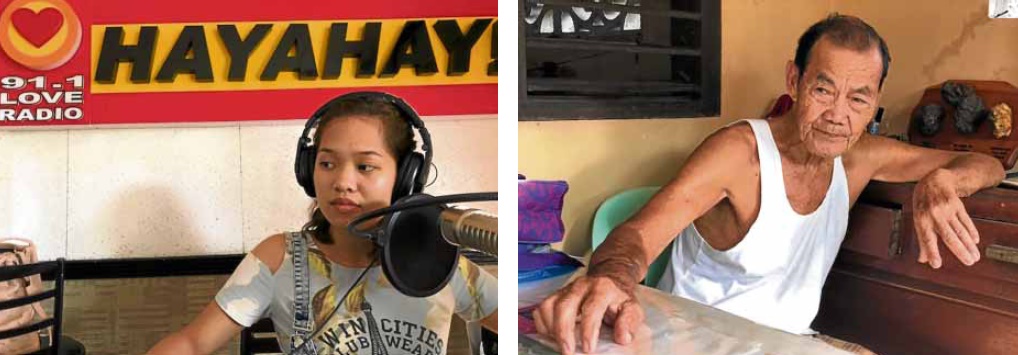Lone woman in historic Balangiga uprising gets recognition

HEROINE CELEBRATED Oriculo Amano (right photo), the 85-year-old grandnephew of Balangiga heroine Casiana Nacionales, believes his church-going grandaunt was moved to join the Filipino guerrillas who attacked a garrison of American soldiers 117 years ago because her brother was unjustly jailed. Popular DJ Emily Montallana (left photo) says she is thrilled to play the role of Nacionales in the annual reenactment of the Sept. 28, 1901, uprising that killed 44 American soldiers in the biggest US debacle in the Philippine-American War. —DANNY PETILLA/CONTRIBUTOR
BALANGIGA, EASTERN SAMAR — Hers was the voice that sounded loud as the bells that the American invaders took away. But the role of Casiana Nacionales, the only woman to join that daring surprise attack against American soldiers on Sept. 28, 1901, has been largely overlooked, until fairly recently.
With her story absent in official history texts, a youthful generation of her descendants from this coastal town composed mostly of women is leading efforts to give recognition and preserve her legacy of uncommon courage and patriotism.
“She was always praying and singing in church. We learned that from our elders,” said Fe Campanero, the town’s tourism and cultural officer who is also a great-great-grandniece of Nacionales.
According to local lore, Nacionales, while holding up her rosary, shouted, “Attack, my fellow Filipinos,” as she rallied the guerrillas in the assault against the Americans who were preparing for breakfast on that Saturday morning 117 years ago today.
The guerrillas killed 44 soldiers from Company C of the 9th Infantry Regiment. In retaliation, the US military waged a “kill and burn” policy, leaving thousands of Filipinos dead.
Article continues after this advertisementAnnual dance drama
Article continues after this advertisementThe atrocities resulted in the court-martial of two US officers, and the Americans decided to end their war in the Philippines.
“If the Ilocanos have Gabriela Silang and the Tagalogs have Tandang Sora (Melchora Aquino), we Warays have our Casiana Nacionales,” said Danny Ablay, 37, a town councilor who has been playing the role of Balangiga hero Capt. Valeriano Abanador—the town’s police chief who planned and led the Balangiga uprising—in the annual dance drama reenactment for 10 years now.
Most historians now claim that the arrest of Eugenio “Guno” Nacionales, Casiana’s younger brother who was imprisoned without food and water, may have motivated her to join the attack against the 74 American soldiers garrisoned near the town plaza.
“Why would a church-going woman join in this attack? The arrest of Guno may have been the last straw,” said 85-year-old Oriculo Amano, Nacionales’ grandnephew who received motherly care from her.
Nacionales’ role in that uprising that resulted in the worst debacle for the Americans during the 1899-1902 Philippine-American War has been overshadowed by the male narrative in books and oral history.
The woman who hid bolos under her skirt for the guerrillas is not even depicted in Napoleon Abueva’s life-size Balangiga Memorial sculpture in the center of town.
Role of heroine
But her rallying call on that bloody battleground, brandishing her rosary like a weapon, will be reenacted today at the town auditorium with 20-year-old Emily Montallana playing the role of Balangiga’s famous heroine.
“I am so thrilled to play her since I learned about her legendary life when I was 11,” said Montallana, a Balangiga native who is a famous disc jockey at MOR Love Radio in Tacloban City.
Separate scripts that were written by Butch Dalisay and Pete Lacaba but have not yet been made into film had an American sergeant named Frank Betron flirting with then 23-year-old Nacionales.
Tease from cousin
The latest movie about that historic episode, “Balangiga: Howling Wilderness” by Khavn de la Cruz, does not mention Nacionales at all.
The second daughter of Ruben Nacionales and Ana Salazar, and known as Apoy Sana to her relatives and Doday Sana to the townsfolk, Nacionales was also called Geronima, her nom de guerre in the Katipunan.
Geronima is a variation of Geronimo, the name of the Apache warrior who gained fame for his raids on US soldiers who tried to subjugate the American Indians from the 1850s to the 1880s.
“That nickname was a tease from her cousin, Captain Abanador, while she joined the secret meetings as the only woman plotter of the attack,” said Rolando Borrinaga, an acknowledged authority on Balangiga whose 2003 book, “The Balangiga Conflict Revisited,” tries to sift fact from fiction about the uprising.
“We did not learn that from history books. We learned that from the rich oral tradition in our community,” added Kenneth Gales, 34, Balangiga’s unofficial historian who lives in a house along Geronima Street, named after its famous Balangiga native.
Overshadowed by the giant personas of Abanador, Capt. Eugenio Daza of the revolutionary government and Balangiga Mayor Pedro Abayan, three of the leaders of the attack, the proud legacy of Nacionales was largely relegated to the sidelines.
Oral histories
This legacy was almost forgotten until scholarly journals and college theses that mined the oral histories of Nacionales’ descendants came out in the 1990s across Leyte and Samar that told the story of the heroine of Balangiga.
“Geronima became the model of strength not only to the women but also to the men as well,” UP professor Glenda Lynne Anne Tibe-Bonifacio said in a historical paper she presented on Oct. 21, 1998, before the Philippine National Historical Society.
What could be a likeness of Nacionales is on the cover of “Insurrecto,” the latest book by New York-based novelist Gina Apostol who was born in Leyte province.
Apostol was given permission by National Artist Ben Cabrera to use his painting, “Woman with Fan,” to represent Nacionales. The book will be released by Penguin Books in November.
“Hers is the face of Casiana Nacionales, the Geronima of Balangiga,” Apostol said on her Facebook fan page.
Nacionales, the pious heroine and freedom fighter of Balangiga, remained unmarried and died on May 11, 1953, according to the town registry. —CONTRIBUTED